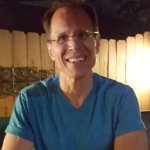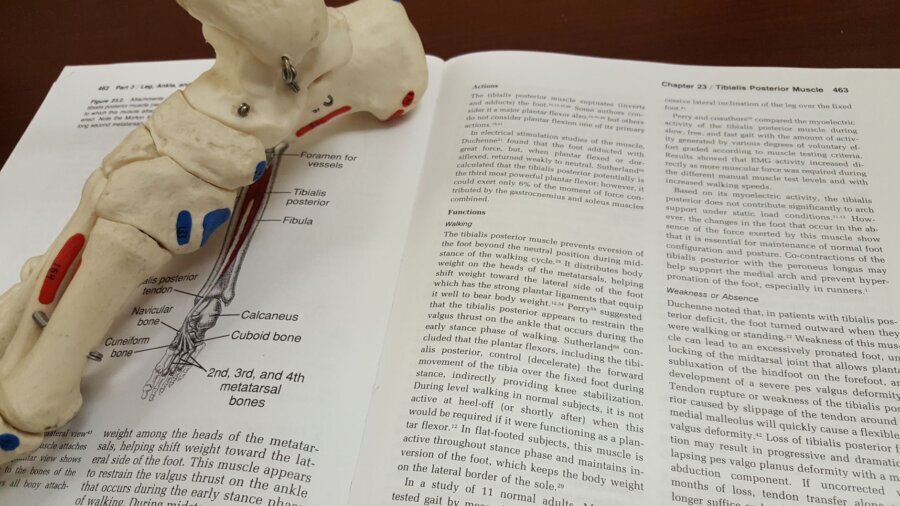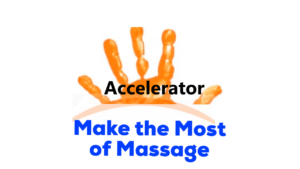If you work with athletes or someone with flat feet, you may have already encountered tibialis posterior tendonitis (TPT). A person with TPT may feel pain in the arch of the foot, medial side of the ankle and/or deep in the calf. A tibialis posterior pain reduction massage might be in order.
I’ve found 2 keys to helping a client walk out of my office in less pain: 1. Look for pain in 3 places 2. Give the right dose of pressure.
Lost Arch—Almost
My first true case of working with a tibialis posterior condition turned out to be a tendon tear. In the past, Tom had come to see me for a stiff neck and a frozen shoulder. But when he came in with extreme pain in his arch/ankle with reduced foot functionality, I knew he was waay beyond anything I could do to help him.
He went to the orthopedist and eventually found out that his tib posterior tendon was 80% torn. Yikes! If it went completely, the surgeon said, Tom would completely lose his arch and wouldn’t be able to do the recreational activities that he loved, like running and basketball.
Tom had his tib post surgically repaired and it was a huge success. Now I work on his tib post for minor aches and pains. Since Tom, I’ve worked on many runners with tib post tendonitis. Needless to say, I’ve gotten to know the tib post quite well.
The Tib Post Big Picture

The tibialis posterior is the deepest muscle in the posterior calf (underneath the gastrocnemius and soleus). It’s main attachments are the inner posterior borders of the medial tibia and fibula, the interroseus membrane (membrane between the tibia and fibula), the tuberosity of the navicular bone, the plantar surface of the 1st cuneiform and at the bases of the 2nd, 3rd and 4th metatarsals.
Tib Post in 3 Sections
I divide the tib post into 3 parts to make it easy to remember. Here they are: 1. Foot, 2. Tendon, 3. Body.
Foot Attachments—Find the Tuberosity of the Navicular Bone
In the foot, the tib post attaches at the base of metatarsals 2, 3, and 4, the navicular tuberosity and the middle cuneiform.

(Picture from https://commons.wikimedia.org/wiki/File:Slide2wewe.JPG)
Don’t sweat the attachments. If you find the navicular tuberosity, the rest is gravy. Why? Because the navicular tuberosity is an area that you’ll really want to investigate, and once you find it, you can use it as a reference point to locate the middle cuneiform and metatarsals.
In this video, Finding the Tibialis Posterior Navicular Attachment, I show you the quick and easy way to locate tib post navicular attachment.
Tendon Section
To locate the tib post tendon, put your fingers on the medial malleolus. Now go slightly posterior of the malleolus and down.
If you’re doing a parts body massage, have the person invert her foot as you resist with your hand and the tendon will become more prominent.
Calf Section
Now for the body of the tib post: In your brain, draw a straight line from the Achilles tendon ¾ of the way up the lower leg. At the ¾ mark up the calf is approximately the location of the interroseus membrane, one area where tib post attaches. Between the Achilles and the interroseus membrane is the body of the muscle.
Goldilocks Pressure for the Tibialis Posterior Pain Reduction Massage
Once you locate the tibialis posterior, your next goals are to find the areas of pain and then reduce the pain. You are going to reduce pain by applying a therapeutic (pain relief) pressure.
Too much pressure may cause your client to tighten up and/or may add to an unwanted inflammatory response. Not enough pressure and it’s unlikely you’ll facilitate a pain relief response.
The right amount of pressure can be easily determined by introducing a pain scale to your client. The scale is 1 to 10. One is a little bit of pain. And 10 is a whole lot of pain.
Press on a pain area and ask your client to tell you when the pain reaches a 4 on her pain scale. Hold at that 4 pressure for less than 10 seconds. Ask the client if the pain stayed the same or went up or went down. If the pain went down, you may try applying a little more pressure when you come back to that area again during the massage. If it didn’t, lighten the pressure and try again until the pain goes down.
Once you get your client’s “4”, you don’t need to check in with her regarding pressure except when you’re in doubt.
In this video, I show you how to use the pain scale to find the right pressure: Pain Relief Massage–How to Find the Right Pressure.
Some clients know which pressure is best for them because they’ve had a lot of massage. In those cases, I would, more often than not, go with the client’s request.
Tibialis Posterior Pain Reduction Massage Combined with Relaxation Massage
Here’s what post tib work could look like if you were incorporating it into a relaxation or body parts massage: Tibialis Posterior: How to Do Pain Relief Massage Video
Tibialis Posterior Pain Reduction Massage Cliff’s Notes
Here’s your quick reference guide:
a. Navicular: Find the tuberosity of the navicular bone. Then you can find all the other foot attachments if necessary.
b. Tendon and Body: The tendon is on the medial ankle side. The body of he muscle is in the middle of the calf and deep.
Video: Finding the Tibialis Posterior Navicular Attachment.
c. Keep pressure at 4 if you’re unsure.
Video: Pain Relief Massage–How to Find the Right Pressure
d. Integrate into relaxation.
Video: Tibialis Posterior: How to Do Pain Relief Massage
Tibialis Posterior Pain Reduction Massage + ?
Lastly, a massage is not going to cure tibialis posterior tendonitis. It can help someone on the road to recover, but the cause (or perpetuating factors) for the tendonitis needs to be addressed.
Personally, I reach out to podiatrists, orthopedists, physical therapists, coaches, and select body movement instructors (e.g. Pilates and yoga). For me, a combined efforts approach has produced great outcomes both for my clients and my business.

Want more information about pain relief massage?
Check out My (Simple) Secret To Pain Relief Massage.
Just need more help with…well…everything?
Join my email group.
I send you my latest everything.
It’s free:-)
Sign up below.
[contact-form][contact-field label=’Name’ type=’name’ required=’1’/][contact-field label=’Email’ type=’email’ required=’1’/][/contact-form]






